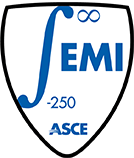PoroMechanics of MicroPorous Solids
Laboratoire Navier
Problems
A wide range of materials (soils, concrete, wood,...) related to civil or petroleum engineering applications are porous. For all those porous materials, their behavior can be significantly modified by the presence of various fluids (air, water, oil,...) in their pore network. The study of the mechanical behavior of such systems is well tackled within the framework of poromechanics, pioneered by Biot and extended by Coussy and others. But some of those materials (e.g., clay-based materials or coal) contain micropores, i.e., pores with a radius smaller than 1nm. In such tiny micropores, the molecules of the pore fluid are very close to the atoms of the solid skeleton and interact physically with them: those molecules are said to be adsorbed. Adsorption can lead to surprising mechanical effects and explains for instance why underground microporous coal swells more in presence of CO2 than in presence of CH4 at the same pressure. This differential swelling is of primary importance for CO2 storage in coal seams, since it leads to a decrease of injectivity of the seam over the injection process: this phenomenon must be accurately modeled to estimate the economic viability of the process. But how to take into account the effect of adsorption on the mechanical behavior of a solid?
Approach
For the specific case of the poromechanical behavior of coal in presence of CO2, we combine a theoretical approach with molecular simulations, experimental characterization, and finite-element simulations. Thermodynamics (i.e., an energy-based approach) was used to derive the equations that govern the poromechanical behavior of a microporous solid such as coal. Molecular simulations were performed (in collaboration with R. J.-M. Pellenq) to study how fluids are adsorbed in coal. The model is being validated and calibrated with experiments consisting in characterizing the adsorption of CO2 in intact coal cores under an anisotropic state of stresses and controlled temperature (a triaxial cell was specifically designed for that purpose). The model was implemented in a finite-element code to perform simulations at the scale of a coal seam.
Findings
Thermodynamic derivations as well as molecular simulations show that adsorption is coupled with stress or strain: the adsorptive properties of a microporous solid depend on the stress (or on the strain) to which it is subjected. On the other hand, adsorption can generate stresses or strains. Microporous solids exhibit counterintuitive properties. For instance, we show that a solid that behaves linearly with respect to the applied stress in absence of any fluid can behave non-linearly in presence of fluid. Also, the Biot coefficient of microporous solids can be greater than unity (without violating any law of thermodynamics). The equations that govern the poromechanical behavior of microporous solids have been derived for isotropic solids saturated by a pure fluid or by a binary mixture of fluids. Extensions to transverse isotropy are underway.
Impact
The performed research leads to a better understanding and a better modeling of how fluid leads to strains in microporous solids. The results can readily be applied for CO2 storage in coal seams or for CO2-enhanced coal bed methane recovery (which consists in increasing the amount or methane recovered from a coal seam by injecting carbon dioxide into it), but could also be applied for other underground materials such as shales or clays. For materials science in general, those results are valuable for any microporous solid, such as zeolites or metal-organic frameworks.
Core competencies
- Mechanics and physics of porous solids
- Cementitious materials and geomaterials.
- Adsorption-induced deformations
- Thermo-hydro-chemo-mechanical couplings
Current research team members
- Matthieu Vandamme (PI)
- Patrick Dangla (Researcher)
- Jean-Michel Pereira (Researcher)
- Teddy Fen-Chong (Researcher)
- Nicolas Espinoza (Postdoctoral researcher)
- Saeid Nikoosokhan (PhD student)
Recent graduates and co-workers
- Laurent Brochard (co-supervised PhD 2011), Postdoctoral associate, Civil and Environmental Engineering department, MIT
Current research collaborations
- Elastic and creep properties of clay films, with Roland J. Pellenq (CNRS and MITCSHub), and Henri Van Damme (IFSTTAR and ESPCI ParisTech)
- X-ray tomography study of water-induced collapse in granular media, with Michel Bornert and Pierre Delage (Lab. Navier)
- Swelling of porous media induced by supersaturation and crystal growth, with Rémi Barbarulo and Gilles Chanvillard


